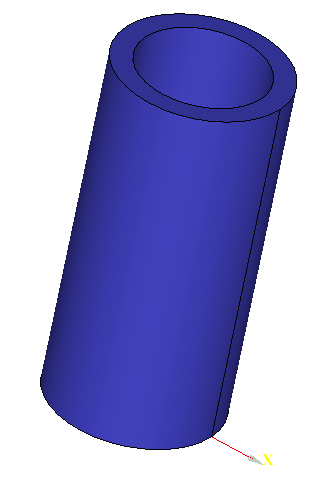1. Reference problem#

1.1. Geometry#
The structure consists of a tube in which a fluid carrying the thermal shock circulates.
Straight tube section
Tube length: \(L=0.1m\)
Outer tube diameter: \({\varphi }_{\mathit{ext}}=0.048m\)
Tube Thickness: \(e=0.006m\)
1.2. Material properties#
\(\lambda =15W/m°C\) Thermal Conductivity Coefficient
\({C}_{P}=500J/\mathit{Kg}°C\) Specific heat
\(a=3.8x{10}^{-6}{m}^{2}/s\) Thermal diffusivity
\(E=200000\mathit{MPa}\) Young’s module
\(\nu =0.3\) Poisson’s Ratio
\(\alpha =15x{10}^{-6}/°C\) Coefficient of thermal expansion
1.3. Boundary conditions and loads#
The thermal shock is transmitted to the tube by the fluid via convective exchange. Two thermal shocks are studied:
Thermal shock |
Intrados |
Extrados |
\(\Delta T=1°C\) |
|
|
\(\Delta T=50°C\) |
|
|
Thermal shock corresponds to the difference between the initial temperature of the tube and that of the fluid.
The flow is zero in the axial direction of the tube (\(\frac{\partial T(x,t)}{\partial z}=0\)).
For mechanical analysis, the tube is locked at its base in the axial direction.
1.4. Initial conditions#
\(T(x,t=0)=20°C\) for the \(\mathrm{\Delta }T=50°C\) shock
\(T(x,t=0)=20°C\) for the unity shock \(\Delta {T}_{U}=1°C\)
1.5. Details concerning the models#
To define time discretization, we use the time constant \(\tau =\frac{{e}^{2}}{(a{\pi }^{2})}=1s\), which gives us, in the case of a thermal shock, the instant beyond which the thermal behavior becomes almost stationary in the tube. The duration of the thermal shock is set to \({10.}^{-1}s\). We chose discretization in the following time:
5 |
not for |
\([0.0,0.1]\) |
either |
\(\Delta t=0.01s\) |
4 |
not for |
\([0.1,0.5]\) |
either |
\(\Delta t=0.04s\) |
4 |
not for |
\([0.5,3.0]\) |
either |
\(\Delta t=0.25s\) |
1 |
not for |
\([3.0\mathrm{,5}.0]\) |
either |
\(\Delta t=0.4s\) |
1 |
not for |
\([5.0\mathrm{,10}\mathrm{.}]\) |
either |
\(\Delta t=2.5s\) |